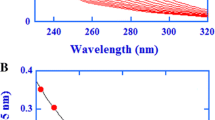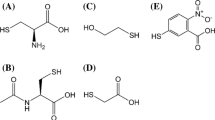Abstract
Small sulfur-containing compounds are involved in several important biochemical processes, including—but not limited to—redox regulation and drug conjugation/detoxification. While methods for stable redox pairs of such compounds (thiols/disulfides) are available, analytical data on more labile and short-lived redox intermediates are scarce, due to highly challenging analytical requirements. In this study, we employ the direct combination of reagentless electrochemical oxidation and mass spectrometric (EC-MS) identification for monitoring oxidation reactions of cysteine, N-acetylcysteine, methionine, and glutathione under simulated physiological conditions (pH 7.4, 37 °C). For the first time, all theoretically expected redox intermediates—with only one exception—are detected simultaneously and in situ, including sulfenic, sulfinic, and sulfonic acids, disulfides, thiosulfinates, thiosulfonates, and sulfoxides. By monitoring the time/potential-dependent interconversion of sulfur species, mechanistic oxidation routes are confirmed and new reactions detected, e.g., sulfenamide formation due to reaction with ammonia from the buffer. Furthermore, our results demonstrate a highly significant impact of cisplatin on the redox reactivity of sulfur species. Namely, the amount of thiol oxidation to sulfonic acid via sulfenic and sulfinic acid intermediates is diminished for glutathione in the presence of cisplatin in favor of the disulfide formation, while for N-acetylcysteine the contrary applies. N-acetylcysteine is the only ligand which displays enhanced oxidation currents upon cisplatin addition, accompanied by increased levels of thiosulfinate and thiosulfonate species. This is traced back to thiol reactivity and highlights the important role of sulfenic acid intermediates, which may function as a switch between different oxidation routes.

Electrochemistry-Mass spectrometry reveals changes in the oxidation pathway of thiols in the presence of cisplatin and enables detection of labile reaction intermediates





Similar content being viewed by others
References
Dickinson DA, Forman HJ. Cellular glutathione and thiols metabolism. Biochem Pharmacol. 2002;64:1019.
Couturier J, Chibani K, Jacquot JP, Rouhier N. Cysteine-based redox regulation and signaling in plants. Frontiers Plant Sci. 2013;4:105.
Gupta V, Carroll KS. Sulfenic acid chemistry, detection and cellular lifetime. Biochim Biophys Acta. 2014;1840:847.
Reddie KG, Carroll KS. Expanding the functional diversity of proteins through cysteine oxidation. Curr Opin Chem Biol. 2008;12:746.
Finkel T. Signal transduction by reactive oxygen species. J Cell Biol. 2011;194:7.
Zimmerman MT, Bayse CA, Ramoutar RR, Brumaghim JL. Sulfur and selenium antioxidants: challenging radical scavenging mechanisms and developing structure-activity relationships based on metal binding. J Inorg Biochem. 2015;145:30.
Huska D, Zitka O, Adam V, Beklova M, Krizkova S, Zeman L, et al. A sensor for investigating the interaction between biologically important heavy metals and glutathione. Czech J Anim Sci. 2007;52:37.
Huang KP, Huang FL. Glutathionylation of proteins by glutathione disulfide S-oxide. Biochem Pharmacol. 2002;64:1049.
Szajewski RP, Whitesides GM. Rate constants and equilibrium constants for thiol-disulfide interchange reactions involving oxidized glutathione. J Am Chem Soc. 1980;102:2011.
Messens J, Collet JF. Thiol-disulfide exchange in signaling: disulfide bonds as a switch. Antiox Redox Signal. 2013;18:1594.
Hopmann KH. Full reaction mechanism of nitrile hydratase: a cyclic intermediate and an unexpected disulfide switch. Inorg Chem. 2014;53:2760.
Akam EA, Chang TM, Astashkin AV, Tomat E. Intracellular reduction/activation of a disulfide switch in thiosemicarbazone iron chelators. Metallomics. 2014;6:1905.
Hogg PJ. Disulfide bonds as switches for protein function. Trends Biochem Sci. 2003;28:210.
Kim HJ, Ha S, Lee HY, Lee KJ. ROSics: chemistry and proteomics of cysteine modifications in redox biology. Mass Spectrom Rev. 2015;34:184.
Martinez S, Wu R, Sanishvili R, Liu D, Holz R. The active site sulfenic acid ligand in nitrile hydratases can function as a nucleophile. J Am Chem Soc. 2014;136:1186.
Claiborne A, Mallett TC, Yeh JI, Luba J, Parsonage D. Structural, redox, and mechanistic parameters for cysteine-sulfenic acid function in catalysis and regulation. Adv Protein Chem. 2001;58:215.
Paulsen CE, Truong TH, Garcia FJ, Homann A, Gupta V, Leonard SE, et al. Peroxide-dependent sulfenylation of the EGFR catalytic site enhances kinase activity. Nature Chem Biol. 2012;8:57.
Chiu J, Tactacan CM, Tan SX, Lin RCY, Wouters MA, Dawes IW. Cell cycle sensing of oxidative stress in Saccharomyces cerevisiae by oxidation of a specific cysteine residue in the transcription factor Swi6p. J Biol Chem. 2011;286:5204.
Bachi A, Dalle-Donne I, Scaloni A. Redox proteomics: chemical principles, methodological approaches and biological/biomedical promises. Chem Rev. 2013;113:596.
Ghesquiere B, Gevaert K. Proteomics methods to study methionine oxidation. Mass Spectrom Rev. 2014;33:147.
Xu G, Chance MR. Radiolytic modification of sulfur-containing amino acid residues in model peptides: fundamental studies for protein footprinting. Anal Chem. 2005;77:2437.
Triquigneaux M, Tuccio B, Charles L. Combining EPR and ESI-MS/MS to study the reactivity of alkylthiols and cysteine towards 2-methyl-2-nitrosopropane (MNP). Anal Methods. 2010;2:694.
Maeda H, Wu HY, Yamauchi Y, Ohmori H. Important role of the 3-mercaptopropionamide moiety in glutathione: promoting effect on decomposition of the adduct of glutathione with the oxoammonium ion of TEMPO. J Org Chem. 2005;70:8338.
Noguchi T, Nojiri M, Takei K, Odaka M, Kamiya N. Protonation structures of cys-sulfinic and cys-sulfenic acids in the photosensitive nitrile hydratase revealed by Fourier transform infrared spectroscopy. Biochemistry. 2003;42:11642.
Gori SS, Lorkiewicz P, Ehringer DS, Belshoff AC, Higashi RM, Fan TWM, et al. Profiling thiol metabolites and quantification of cellular glutathione using FT-ICR-MS spectrometry. Anal Bioanal Chem. 2014;406:4371.
Furdui CM, Poole LB. Chemical approaches to detect and analyze protein sulfenic acids. Mass Spectrom Rev. 2014;33:126.
Reddie KG, Seo YH, Muse III WB, Leonard SE, Carroll KS. A chemical approach for detecting sulfenic acid-modified proteins in living cells. Mol BioSyst. 2008;4:521.
Federova M, Kuleva N, Hoffmann R. Identification of cysteine, methionine and tryptophan residues of actin oxidized in vivo during oxidative stress. J Proteome Res. 2010;9:1598.
Block E, Dane AJ, Cody RB. Crushing garlic and slicing onions: detection of sulfenic acids and other reactive organosulfur intermediates from garlic and other alliums using direct analysis in real-time mass spectrometry (DART-MS). Phosphorus Sulfur. 2011;186:1085.
Isokawa M, Funatsu T, Tsunoda M. Fast and simultaneous analysis of biothiols by high-performance liquid chromatography with fluorescence detection under hydrophilic interaction chromatography conditions. Analyst. 2013;138:3802.
Schmidt AC, Lauckner S, Lindner K. CZE of sulfur-containing amino acids and peptides and its application to the quantitative study of heavy metal-caused thiol oxidations. Chromatographia. 2012;75:661.
Ismail A, d’Orlye F, Griveau S, Francassi da Silva JA, Bedioui F, Varenne A. Capillary electrophoresis with mass spectrometric detection for separation of S-nitrosoglutathione and its decomposition products: a deeper insight into the decomposition pathways. Anal Bioanal Chem. 2015;407:6221.
Enache TA, Oliveira-Brett AM. Boron doped diamond and glassy carbon electrodes comparative study of the oxidation behaviour of cysteine and methionine. Bioelectrochem. 2011;81:46.
Nantaphol S, Chailapakul O, Siangproh W. Ultrasensitive and simple method for determination of N-acetyl-L-cysteine in drug formulations using a diamond sensor. Electroanalysis. 2014;26:1024.
Lee PT, Lowinsohn D, Compton RG. Simultaneous detection of homocysteine and cysteine in the presence of ascorbic acid and glutathione using a nanocarbon modified electrode. Electroanalysis. 2014;26:1488.
Rojas L, Molero L, Tapia RA, del Rio R, del Valle MA, Antilen M, et al. Electrochemistry behavior of endogenous thiols on fluorine doped tin electrodes. Electrochim Acta. 2011;56:8711.
Spataru N, Sarada BV, Popa E, Tryk DA, Fujishima A. Voltammetric determination of L-cysteine at conductive diamond electrodes. Anal Chem. 2001;73:514.
Masek A, Chrzescijanska E, Zaborski M. Estimation of the antioxidative properties of amino acids—an electrochemical approach. Int J Electrochem Sci. 2014;9:7904.
Bagiyan GA, Koroleva IK, Soroka NV, Ufimtsev AV. Oxidation of thiol compounds by molecular oxygen in aqueous solutions. Russ Chem Bull Int Ed. 2003;52:1135.
Zeida A, Babbush R, Gonzalez Lebrero MC, Trujillo M, Radi R, Estrin DA. Molecular basis of the mechanism of thiol oxidation by hydrogen peroxide in aqueous solution: challenging the SN2 paradigm. Chem Res Toxicol. 2012;25:741.
Carballal S, Radi R, Kirk MC, Barnes S, Freeman BA, Alvarez B. Sulfenic acid formation in human serum albumin by hydrogen peroxide and peroxinitrite. Biochemistry. 2003;42:9906.
Storkey C, Davies MJ, Pattison DI. Reevaluation of the rate constants for the reaction of hypochlorous acid (HOCl) with cysteine, methionine, and peptide derivatives using a new competition kinetic approach. Free Rad Biol Med. 2014;73:60.
Simon H, Melles D, Jacquoilleot S, Sanderson P, Zazzeroni R, Karst U. Combination of electrochemistry and nuclear magnetic resonance spectroscopy for metabolism studies. Anal Chem. 2012;84:8777.
Nunes LMS, Morales TB, Barbosa LL, Mazo LH, Colnago LA. Monitoring electrochemical reactions in situ using steady-state free precession 13C NMR spectroscopy. Anal Chim Acta. 2014;850:1.
McClintock C, Kertesz V, Hettich RL. Development of an electrochemical oxidation method for probing higher order protein structure with mass spectrometry. Anal Chem. 2008;80:3304.
Looi DW, Iftikhar I, Brajter-Toth A. Electrochemical attributes of electrochemistry in tandem with electrospray mass spectrometry. Electroanalysis. 2014;26:319.
Liu P, Lu M, Zheng Q, Zhang Y, Dewald HD, Chen H. Recent advances of electrochemical mass spectrometry. Analyst. 2013;138:5519.
Faber H, Vogel M, Karst U. Electrochemistry/mass spectrometry as a tool in metabolism studies—a review. Anal Chim Acta. 2014;834:9.
Oberacher H, Pitterl F, Erb R, Plattner S. Mass spectrometric methods for monitoring redox processes in electrochemical cells. Mass Spectrom Rev. 2015;34:64.
Büter L, Vogel M, Karst U. Adduct formation of electrochemically generated reactive intermediates with biomolecules. Trends Anal Chem. 2015;70:74.
Jahn S, Karst U. Electrochemistry coupled to (liquid chromatography/) mass spectrometry—current state and future perspectives. J Chromatogr A. 2012;1259:16.
Roscher J, Faber H, Stoffels M, Hachmöller O, Happe J, Karst U. Nonaqueous capillary electrophoresis as separation technique to support metabolism studies by means of electrochemistry and mass spectrometry. Electrophoresis. 2014;35:2386.
Michman M, Appelbaum L, Gun J, Modestov AD, Lev O. Homogeneous catalysis and selectivity in electrochemistry. Organometallics. 2014;33:4729.
Gutkin V, Gun J, Lev O. Stripping analysis of molecules and proteins by online electrochemical flow cell/mass spectrometry. Anal Chem. 2009;81:8396.
Modestov AD, Gun J, Mudrov A, Lev O. Radial electrochemical flow cell for on-line coupling with mass spectrometry: theory and electrooxidation of dimethylaminomethyl ferrocene. Electroanalysis. 2004;16:367.
Zabel R, Kullmann M, Kalayda GV, Jaehde U, Weber G. Optimized sample preparation strategy for the analysis of low molecular mass adducts of a fluorescent cisplatin analogue in cancer cell lines by CE-dual-LIF. Electrophoresis. 2015;36:509.
Dickey DT, Muldoon LL, Doolittle ND, Peterson DR, Kraemer DF, Neuwelt EA. Effect of N-acetylcysteine route of administration on chemoprotection against cisplatin-induced toxicity in rat models. Cancer Chemother Pharmacol. 2008;62:235.
Appenroth D, Winnefeld K, Schröter H, Rost M. Beneficial effect of acetylcysteine on cisplatin nephrotoxicity in rats. J Appl Toxicol. 1993;13:189.
Luo J, Tsuji T, Yasuda H, Sun Y, Fujigaki Y, Hishida A. The molecular mechanisms of the attenuation of cisplatin-induced acute renal failure by N-acetylcysteine in rats. Nephrol Dial Transplant. 2008;23:2198.
Johansson T, Weidolf L, Jurva U. Mimicry of phase I drug metabolism—novel methods for metabolite characterization and synthesis. Rapid Commun Mass Spectrom. 2007;21:2323.
Miao R, Yang G, Miao Y, Mei Y, Hong J, Zhao C, et al. Interactions of platinum(II) complexes with sulfur-containing peptides studied by electrospray ionization mass spectrometry and tandem mass spectrometry. Rapid Commun Mass Spectrom. 2005;19:1031.
Acknowledgments
We thank the Deutsche Forschungsgemeinschaft for financial support (grant WE 2422/7-1). The financial support from the Ministerium für Innovation, Wissenschaft und Forschung des Landes Nordrhein-Westfalen and by the Bundesministerium für Bildung und Forschung is also gratefully acknowledged.
Author information
Authors and Affiliations
Corresponding author
Ethics declarations
Conflict of interest
The authors declare that they have no competing interests.
Electronic supplementary material
Below is the link to the electronic supplementary material.
ESM 1
(PDF 8008 kb)
Rights and permissions
About this article
Cite this article
Zabel, R., Weber, G. Comparative study of the oxidation behavior of sulfur-containing amino acids and glutathione by electrochemistry-mass spectrometry in the presence and absence of cisplatin. Anal Bioanal Chem 408, 1237–1247 (2016). https://doi.org/10.1007/s00216-015-9233-x
Received:
Revised:
Accepted:
Published:
Issue Date:
DOI: https://doi.org/10.1007/s00216-015-9233-x




